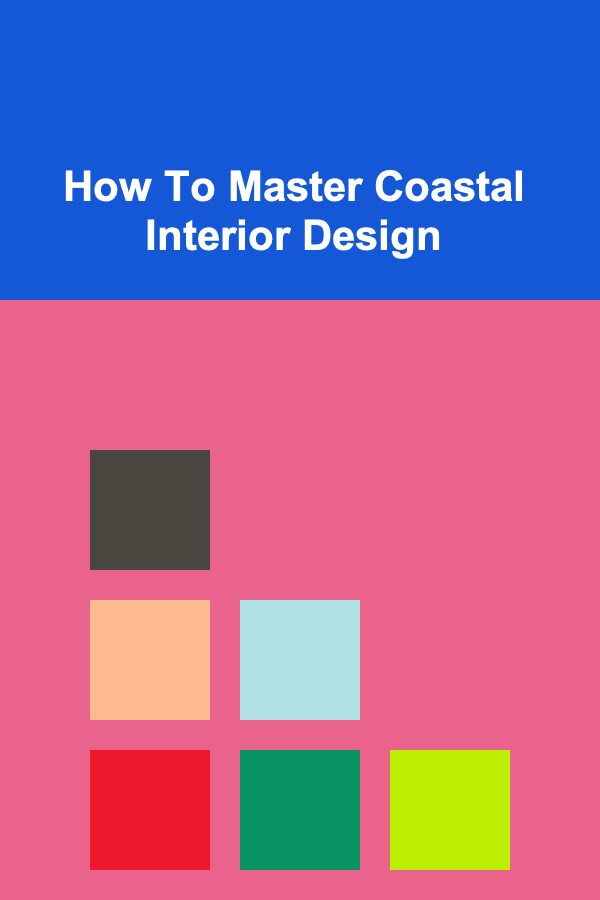
How To Master Coastal Interior Design
ebook include PDF & Audio bundle (Micro Guide)
$12.99$5.99
Limited Time Offer! Order within the next:

Coastal interior design captures the essence of relaxed, beachy elegance and brings the refreshing and tranquil ambiance of the ocean into your home. The goal is to create a living space that feels light, airy, and inspired by nature, utilizing natural materials, soft colors, and textures that remind us of the beach. Mastering coastal interior design involves understanding the interplay between these elements to create a harmonious environment. Whether you live near the ocean or simply want to evoke its serene charm, there are key principles and tips that can help you achieve a coastal-inspired space that feels both chic and inviting.
Embrace Light and Airy Spaces
One of the core tenets of coastal interior design is the use of natural light. The beach is inherently linked to vast, open skies and shimmering sunlight. To recreate that feeling in your home, prioritize spaces with large windows or glass doors. The aim is to maximize natural light and make the room feel open and breezy.
How to achieve this:
- Windows and Doors: Opt for floor-to-ceiling windows if possible, and incorporate sliding glass doors to allow easy access to the outdoors and enhance the indoor-outdoor flow.
- Sheer Curtains: Choose light, airy curtains made from linen or cotton that allow natural light to filter through. Avoid heavy or dark draperies that block the light.
- Light Walls: Use light colors on walls, like soft whites, sandy neutrals, or pale blues, which can reflect light and make rooms feel more open.
Maximizing the flow of natural light will immediately bring the expansive feeling of the outdoors into your home, setting the stage for a coastal vibe.
Use a Natural Color Palette
A key feature of coastal interior design is the color palette, which mirrors the soothing colors of the sea and sky. Coastal spaces often evoke feelings of calm, which can be achieved by using light and muted colors. These hues should bring to mind the soft colors of the beach, seafoam, and the clear blue sky.
How to achieve this:
- Blues and Whites: Incorporate shades of blue, from pale aqua to deep navy, and pair them with fresh whites. The blue represents the sea, while white symbolizes the sand and clouds, together creating a peaceful ambiance.
- Neutrals: Incorporate sandy beiges, taupes, and greys, which evoke the natural elements of the beach. Neutral tones also create a soothing backdrop for other accent colors and textures.
- Accents of Green: Incorporating shades of green, like seafoam or light moss, can represent the natural plant life that grows near coastal environments. Use green sparingly in accessories, textiles, or plants.
By focusing on soft, serene colors, you can easily evoke the tranquility of coastal landscapes without overwhelming the space.
Incorporate Natural and Textural Elements
Coastal design revolves around natural materials that bring the outside in. The goal is to make the space feel grounded in nature while still retaining elegance and comfort. Incorporating textures that mimic the environment's natural elements helps create that cozy, lived-in feel.
How to achieve this:
- Wood: Use reclaimed wood or driftwood for furniture or accent pieces. Wooden floors or furniture, painted or left in their natural state, bring warmth and a touch of the outdoors inside.
- Stone and Shells: Incorporate natural stone or use sea shells as decor, whether as part of a collection on a shelf or embedded in accessories. A stone fireplace, if applicable, can also add a natural touch.
- Rattan and Wicker: These materials are a hallmark of coastal living. Use rattan or wicker furniture for dining chairs, lounge seating, or baskets to add texture and visual interest.
- Textiles: Linen, cotton, and other natural fabrics should be your go-to for upholstery, cushions, throws, and bedding. These materials are breathable, light, and comfortable, perfect for a coastal vibe. A mix of chunky knit throws and light linen curtains creates a relaxed but stylish atmosphere.
The key to achieving coastal design is embracing these organic textures, allowing them to tell a story about nature, light, and serenity.
Focus on Light, Relaxed Furniture
Coastal interior design is synonymous with comfortable, welcoming spaces. The furniture you choose should promote relaxation and ease. Forget about rigid, formal pieces and instead opt for relaxed, casual designs that make people want to sit back and unwind.
How to achieve this:
- Slipcovered Sofas: Choose sofas with slipcovers in neutral or muted tones. These sofas are not only easy to maintain, but they also add to the light, breezy atmosphere that coastal design demands.
- Low Furniture: Coastal interiors often feature low-profile furniture that keeps the space open and airy. Choose coffee tables or side tables that sit lower to the ground to allow an unobstructed flow of space.
- Oversized Cushions: Large, plush cushions on sofas and chairs create a relaxed, beachy vibe. Choose natural fabrics, such as linen or cotton, for a laid-back feel.
- Minimalist Design: Coastal design favors simple, clean-lined furniture that doesn't overwhelm the space. Choose pieces that are functional and allow the beauty of the materials and the natural light to shine through.
The furniture should support a lifestyle that emphasizes comfort and ease, with an aesthetic that blends effortlessly into the beach-inspired atmosphere.
Bring the Outdoors In
Coastal design is all about creating a seamless connection between the indoors and outdoors. Nature is one of the most important elements of coastal living, and incorporating natural elements into your design enhances the beach-inspired vibe.
How to achieve this:
- Indoor Plants: Incorporate plants that are native to coastal areas, such as palms, ferns, or succulents. These plants can be used to fill empty spaces and bring a touch of greenery to your home.
- Open Spaces: Create seamless transitions between your indoor and outdoor spaces. Open up to a deck, patio, or balcony with folding glass doors or large windows that lead out to the garden. The goal is to blend the two spaces and have the outdoors serve as an extension of your interior.
- Beach-Inspired Decor: Use beach-themed decor such as driftwood, sea glass, coral, and nautical-inspired accessories like ropes or lanterns. These items can enhance the coastal feel without feeling overly thematic or kitschy.
Incorporating natural elements will help your home feel connected to the broader environment, creating a space that flows effortlessly from one room to the next.
Nautical Accents and Accessories
While subtlety is key in coastal design, certain nautical elements can help reinforce the theme without feeling overwhelming. The key is to incorporate nautical details in a sophisticated way, which will elevate the design and add layers of interest.
How to achieve this:
- Nautical Stripes: Incorporating classic nautical stripes in fabrics or patterns can add texture and visual interest. This could be through throw pillows, bedding, or curtains.
- Nautical Art: Art pieces depicting marine life, sailboats, or coastal landscapes can add a personal touch to your coastal design. Opt for simple, unframed prints or photographs for a more contemporary feel.
- Decorative Accents: Subtle accents like woven rope, lantern-style lighting, or maritime-inspired clocks can introduce nautical elements without feeling overdone.
These accents add character and a playful nod to coastal design, while still retaining a sense of elegance and sophistication.
Keep It Simple
Above all, simplicity should be a central principle in mastering coastal interior design. The goal is to create a calm, uncluttered space where you can unwind and relax. Less is more when it comes to coastal design, with an emphasis on clean lines, natural materials, and an open, airy feel.
How to achieve this:
- Decluttered Spaces: Keep surfaces and floors free of unnecessary items. A few well-chosen pieces are all you need to achieve a balanced, harmonious space.
- Open Shelving: Instead of bulky storage cabinets, opt for open shelving that displays simple, functional items like pottery, plants, or beach-inspired decor.
- Neutral Decor: Stick to a neutral palette of colors and materials to create a soothing atmosphere. A few accents in complementary colors can add interest without overwhelming the space.
The simplicity of coastal design allows the natural beauty of your surroundings to take center stage, making your space feel calm and effortlessly elegant.
Conclusion
Mastering coastal interior design is all about embracing nature, light, and simplicity. By using a serene color palette, incorporating natural materials, and focusing on relaxed yet functional furniture, you can create a space that evokes the tranquility of the beach. Add subtle nautical touches, open up your space to the outdoors, and keep the overall design minimal to achieve a coastal-inspired home that feels both inviting and chic. Whether you live near the coast or simply want to bring the beach into your home, these principles will help you create an oasis of calm and comfort that reflects the beauty of the natural world.

How to Avoid Impulse Buying and Save More Money
Read More
How to Avoid Lifestyle Inflation and Stick to Your Financial Goals
Read More
How to Create a Home Budget for Single Income Households
Read More
How to Understand Bird Intelligence and Problem-Solving
Read More
Top Tips for Utilizing Public Beaches and Pools for Recreation This Summer
Read More
Combating Cystic Acne: A Deep Dive into Targeted Treatments
Read MoreOther Products

How to Avoid Impulse Buying and Save More Money
Read More
How to Avoid Lifestyle Inflation and Stick to Your Financial Goals
Read More
How to Create a Home Budget for Single Income Households
Read More
How to Understand Bird Intelligence and Problem-Solving
Read More
Top Tips for Utilizing Public Beaches and Pools for Recreation This Summer
Read More